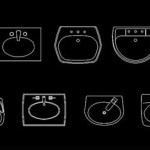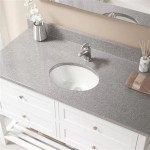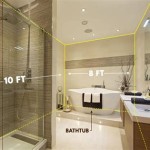Elevating Bathroom Design: Vanity Ideas for Functionality and Style
The bathroom vanity serves as a pivotal element in any bathroom design, providing not only storage and functionality but also contributing significantly to the overall aesthetic. Choosing the right vanity requires careful consideration of space, style preferences, storage needs, and budget. This article explores various bathroom vanity ideas, offering insights into different styles, materials, and design considerations to assist in creating a bathroom that is both practical and visually appealing.
Space Optimization: Small Bathroom Vanity Solutions
Limited space often presents a significant challenge when designing a small bathroom. Maximizing functionality without compromising aesthetics requires strategic planning and the selection of space-saving vanity options. Smaller vanities, typically ranging from 18 to 30 inches in width, are ideal for tight spaces. Wall-mounted vanities are particularly effective in small bathrooms, as they create the illusion of more floor space and simplify cleaning. Consider corner vanities or pedestal sinks with minimal storage for extremely compact bathrooms. The key is to prioritize essential storage and choose designs that minimize visual clutter.
Floating vanities, secured directly to the wall, offer a modern and airy feel. They provide easy access for cleaning beneath and can be installed at a custom height for ergonomic comfort. Another option is to incorporate a narrow, tall cabinet adjacent to the vanity for additional vertical storage. Utilizing mirrored cabinet doors can also enhance the sense of space and light in a small bathroom. Furthermore, selecting a light-colored vanity can visually expand the area, making it appear larger and more open.
When selecting a sink for a small vanity, consider a vessel sink. These sinks sit on top of the vanity counter, minimizing the amount of space needed for the sink basin itself. Alternatively, integrated sinks, where the sink and countertop are made of a single piece of material, offer a seamless and streamlined look. These options help to consolidate space and provide a clean aesthetic in a smaller bathroom setting. Finally, opting for drawers instead of cabinet doors can improve accessibility in tight spaces, allowing for easier reach and organization.
Style and Material Considerations: Matching the Vanity to Your Aesthetic
The material and style of a bathroom vanity should align with the overall design aesthetic of the bathroom. From traditional to contemporary, numerous styles and materials cater to diverse preferences. Wood vanities create a warm and inviting atmosphere, while metal and glass vanities offer a sleek and modern appeal. Stone countertops, such as granite or marble, add a touch of luxury and sophistication. Selecting the right combination of materials and style is crucial to achieving a cohesive and visually appealing bathroom design.
For a traditional bathroom, a vanity with raised panel doors, ornate carvings, and a rich wood finish can create an elegant and timeless look. Pairing it with a marble countertop and antique-style faucets enhances the classic aesthetic. Conversely, a contemporary bathroom benefits from a minimalist vanity with clean lines, a glossy finish, and sleek hardware. Combining it with a quartz countertop and modern faucets contributes to a sophisticated and streamlined appearance. Consider the architectural style of the home and the existing bathroom fixtures when choosing the vanity's style to ensure a harmonious blend.
When considering materials, durability and maintenance are key factors. Solid wood vanities are durable and long-lasting but require proper sealing to prevent moisture damage. MDF (Medium-Density Fiberboard) vanities are a cost-effective alternative, offering a smooth surface for painting and various finishes. Laminate vanities are resistant to water damage and easy to clean, making them a practical choice for busy bathrooms. Stone countertops, such as granite and marble, are heat-resistant and durable but require regular sealing to prevent staining. Quartz countertops are non-porous and resistant to stains and scratches, offering a low-maintenance option. Understanding the properties of each material helps in making an informed decision based on individual needs and preferences.
Storage Solutions: Maximizing Vanity Functionality
One of the primary functions of a bathroom vanity is to provide storage for toiletries, towels, and other bathroom essentials. Efficient storage solutions are crucial for maintaining an organized and clutter-free bathroom. Drawers, cabinets, shelves, and organizers can be incorporated into the vanity design to maximize storage capacity. Consider the types of items to be stored and design the vanity accordingly to ensure everything has a designated place.
Drawers are ideal for storing smaller items such as makeup, toiletries, and grooming tools. Incorporate drawer dividers or organizers to keep items neatly arranged and easily accessible. Cabinets are suitable for storing larger items such as towels, cleaning supplies, and extra toiletries. Adjustable shelves allow for customization and flexibility in storing items of different sizes. Consider incorporating a tilt-out hamper or laundry basket into the vanity design to keep dirty clothes out of sight.
To maximize vertical space, consider adding open shelving to the vanity. Open shelves are perfect for displaying decorative items or storing frequently used items such as towels and washcloths. Installing a medicine cabinet above the vanity mirror provides additional storage for medications and personal care items. Utilizing the space beneath the sink efficiently is crucial. Consider adding a U-shaped drawer or shelf around the plumbing to maximize storage capacity. Additionally, using baskets or containers to organize items within the vanity helps to maintain a tidy and organized space.
Countertop Considerations: Material, Sink Integration and Edge Profiles
Selecting the right countertop material for a bathroom vanity involves balancing aesthetics, durability, and maintenance. Common countertop materials include granite, marble, quartz, solid surface, and laminate, each offering unique characteristics. Sink integration is another critical factor, influencing both the functionality and appearance of the vanity. The edge profile of the countertop, ranging from simple to ornate, adds the finishing touch, complementing the overall bathroom design.
Granite countertops are known for their durability and natural beauty, offering a wide range of colors and patterns. However, granite requires regular sealing to prevent staining and is susceptible to etching from acidic substances. Marble countertops exude luxury and elegance, but they are more porous than granite and require more diligent maintenance. Quartz countertops are engineered stone, offering a non-porous surface that is resistant to stains, scratches, and heat. Solid surface countertops, such as Corian, are seamless and can be molded into various shapes, offering design flexibility. Laminate countertops are a cost-effective option, available in a wide range of colors and patterns, but they are less durable than other materials.
Sink integration options include undermount, overmount (drop-in), vessel, and integrated sinks. Undermount sinks are installed beneath the countertop, creating a seamless and easy-to-clean surface. Overmount sinks are placed on top of the countertop, offering easy installation and a traditional look. Vessel sinks sit on top of the countertop, adding a decorative element to the vanity. Integrated sinks are molded into the countertop, creating a seamless and hygienic surface. The choice of sink integration depends on personal preference, the desired aesthetic, and the practicality of cleaning and maintenance.
The edge profile of the countertop can significantly impact the overall look of the vanity. Common edge profiles include eased, bullnose, ogee, and beveled edges. Eased edges are simple and understated, offering a clean and modern look. Bullnose edges are rounded, providing a soft and comfortable feel. Ogee edges are ornate and decorative, adding a touch of elegance to the vanity. Beveled edges are angled, creating a visual interest and a contemporary appeal. The choice of edge profile should complement the style of the vanity and the overall bathroom design, creating a cohesive and visually appealing space.
Lighting Integration: Enhancing Functionality and Ambiance
Proper lighting is crucial in a bathroom, enhancing both functionality and ambiance. Incorporating lighting into the vanity design can provide task lighting for grooming and makeup application, as well as ambient lighting to create a relaxing atmosphere. Consider integrating LED strip lights, sconces, or pendant lights into the vanity design to optimize illumination and enhance the overall bathroom experience.
LED strip lights can be installed underneath the vanity to provide a soft glow and create a floating effect. They can also be integrated into the vanity mirror to offer direct task lighting for grooming and makeup application. Sconces mounted on either side of the vanity mirror provide balanced and flattering lighting, minimizing shadows and enhancing visibility. Pendant lights suspended above the vanity add a decorative element and provide ambient lighting, creating a warm and inviting atmosphere.
When selecting lighting fixtures, consider the color temperature and brightness. Warm white light (2700-3000K) creates a cozy and relaxing ambiance, while cool white light (3500-4000K) provides brighter and more focused illumination. Adjustable lighting controls allow for customization of the light intensity, catering to different needs and preferences. Ensure that all lighting fixtures are rated for bathroom use and comply with electrical safety standards. Integrating lighting into the vanity design not only enhances functionality but also contributes to the overall aesthetic and creates a comfortable and inviting bathroom space.
DIY Vanity Projects: Customizing Your Bathroom on a Budget
For homeowners seeking to personalize their bathroom and stay within a budget, DIY vanity projects offer a creative and cost-effective solution. Repurposing furniture, refinishing existing vanities, or building a vanity from scratch can create a unique and customized bathroom design that reflects individual style and preferences. Careful planning, preparation, and execution are essential for successful DIY vanity projects.
Repurposing an old dresser or console table into a bathroom vanity can add character and charm to the space. Remove the existing hardware and replace it with modern or vintage-style knobs and pulls to update the look. Seal the wood surface with a water-resistant finish to protect it from moisture damage. Modify the drawers or cabinets to accommodate plumbing and add storage organizers to maximize functionality. This approach allows for creative reuse and reduces waste, while creating a one-of-a-kind vanity.
Refinishing an existing vanity is a simple and affordable way to update its appearance. Start by sanding the surface to remove any old paint or varnish. Apply a primer to prepare the surface for painting. Choose a paint color that complements the bathroom design and apply several thin coats, allowing each coat to dry completely. Seal the painted surface with a clear coat to protect it from moisture and wear. Replace the hardware with new knobs and pulls to complete the transformation. This project can breathe new life into an outdated vanity and create a fresh and modern look.
Building a vanity from scratch allows for complete customization and control over the design and materials. Start by creating a detailed plan that includes dimensions, storage requirements, and desired style. Choose durable and water-resistant materials such as plywood, MDF, or solid wood. Cut the materials according to the plan and assemble the vanity using screws and glue. Add drawers, cabinets, and shelves to maximize storage capacity. Finish the vanity with paint, stain, or varnish to protect it from moisture and enhance its appearance. Building a vanity from scratch requires woodworking skills and attention to detail, but the result is a unique and customized piece that perfectly fits the bathroom space and personal style.

Twin Star Home 25 In W X D Corner Bathroom Vanity Antique Gray With White Top And Basin 25bv35043 Pg22 The Depot

6 Modern Bathroom Vanity Design Ideas Lily Ann Cabinets

27 Bathroom Vanity Ideas

Bathroom Vanity Ideas The Home Depot

Beautiful Bathroom Vanity Ideas Forbes Home

40 Bathroom Vanities You Ll Love For Every Style

Orc Master Bathroom Vanity Ideas Clark Aldine Mi

Best Bathroom Vanity Design Ideas Christopher Scott Cabinetry

30 Black Bathroom Vanity Designs That Will Make A Statement Cabinets
:max_bytes(150000):strip_icc()/258105_9352cff4942f41ca9a569fd19719f30cmv2-1dbb8e2d34e447f1a8ec34f831615b76-37ea3a19ffd34f79b043ef86535a3778.jpeg?strip=all)
26 Bathroom Vanity Ideas That Are Stylish And Functional







